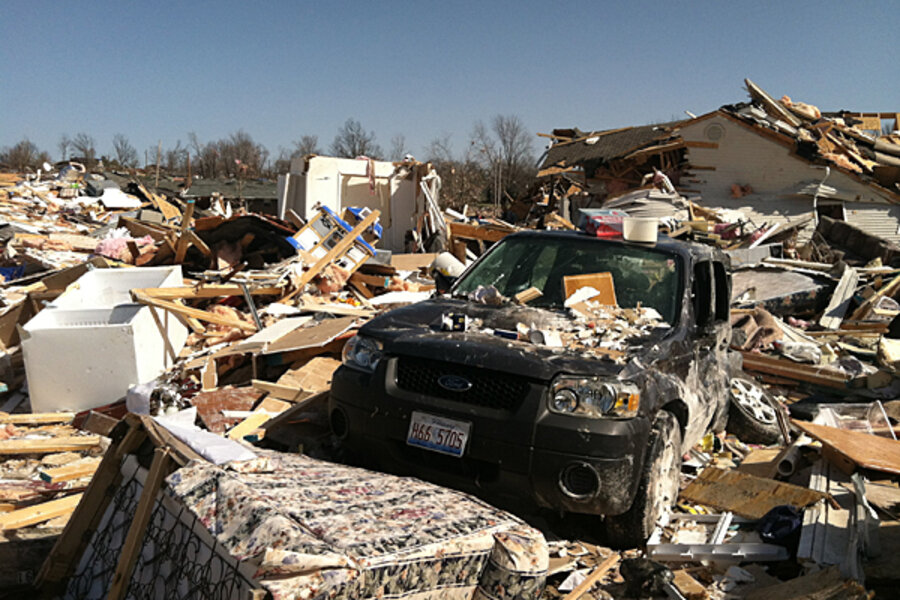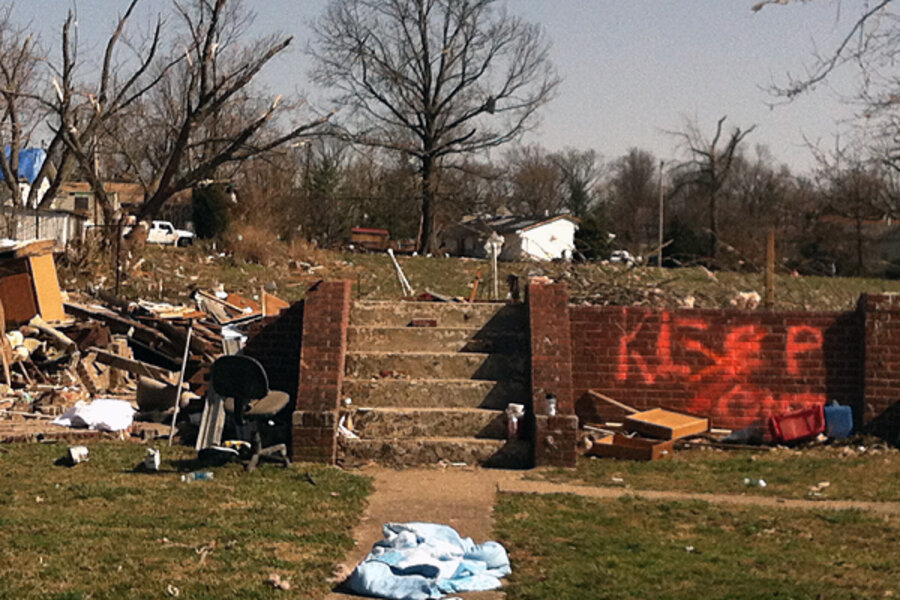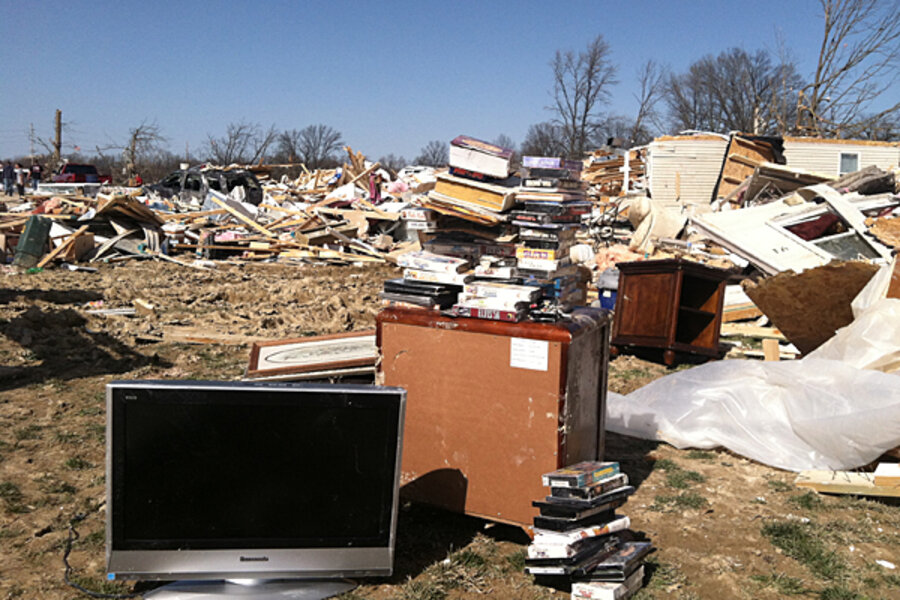Tornado's aftermath: Illinois city is stunned … and roused to action
Loading...
| Harrisburg, Ill.
When Michelle Gunning got a call on her radio before dawn Wednesday that a pregnant woman had been injured by broken glass, she didn’t even know it involved a tornado.
Then Ms. Gunning, a paramedic, pulled her emergency vehicle up to the site of what is being described as an unprecedented natural disaster for this small city in southernmost Illinois: an EF-4 tornado, one notch below the strongest, that destroyed as many as 300 homes and 25 businesses, killed six people, and injured and displaced hundreds more.
With electricity down but live power lines underfoot, Gunning used a flashlight to scramble through a neighborhood of wreckage, but could not find the woman. Instead, in one collapsed structure, she discovered others she dragged to safety. One later died.
“Now what do we do? Nothing compares to this,” she remembers saying.
The storm savaged communities in four adjacent states, but the death toll was highest in this community of about 9,000, once the heart of the Illinois coal industry and still with many surface and underground mines in operation.
Less than 36 hours after the 200-mile-per-hour winds did their damage, the people here are both stunned and roused to action.
Besides emergency personnel arriving from surrounding counties and states, volunteer efforts are materializing in many shapes and sizes: gangs of teenage boys armed with chainsaws looking to cut trees, a work shift of miners ordered above ground and sent to help out, a local Baptist church transformed into a shelter.
“We’re not ones to sit around in southern Illinois. We’re taking the initiative to move forward even if our hearts are broken,” says Harrisburg Mayor Eric Gregg.
Mobilization is everywhere: Busy street corners feature church groups and others handing out free lunches and water to anyone who honks; toys, beds, diapers, and most everything else people would need – when all they have left in life is the pajamas they wore to bed Wednesday night – is arriving by the truckload to two local church halls.
At First Baptist Church, which is sheltering and feeding displaced families with the help of the Red Cross, Deacon Ron Morse, a former two-term mayor of Harrisburg, says his city “has become the center of the universe for all the wrong reasons.”
“Thank God people have stepped up,” Deacon Morse says. “You want to talk about how bad the country is, but when we have a serious situation, people come together. And not just the Christian people, either.”
Volunteers are not yet allowed to enter the perimeter of the storm’s worst damage – a swath more than a mile in length and 200 yards wide – and a 6 p.m. curfew has been established, both for safety reasons and to keep away looters.
Officials say despite being overwhelmed with generous offers to help from more than 25 groups, they are pausing to let former homeowners pick through the ruins to gather whatever they can to remind them of their former homes: a bag of Beanie Babies, a stack of CDs, a sofa.
“Everyone is upset but we have no place for [the volunteers] to go,” says Lt. Tracy Felty with the Saline County Sheriff Office.
The primary damage site, a bedroom community of ranch homes and two-story apartments, was eerily quiet Thursday afternoon as residents assessed what was left, talked with insurance agencies, and mourned.
Tall oak trees looked like they were festooned with Christmas lights, except their branches held orange, pink, and yellow ribbons of home insulation. Cars were flattened in what were once the garages that held them. All that remained of the home of Jaylynn Ferrell, a 22-year-old nurse who was flung 100 yards up a hill where she died, was a foundation holding a shoe, a Santa doll, and a dresser drawer in its belly.
Kera Wise says she drove in from her home seven miles to the south to hunt through the debris of her aunt and uncle’s home, which sat, crushed, atop the home across the street. The plush red recliner, in which her uncle was sleeping, was tucked under planks. Her aunt, she says, is stable, but her uncle remains unresponsive in the hospital.
Ms. Wise hunted on their behalf for mementos, photos and “hopefully a missing dog we’ll find alive.”
Also flattened were a nearby strip mall and the south end of the city’s medical building, which had to evacuate patients and transfer them to other counties.
Illinois Gov. Pat Quinn surveyed the damage Wednesday after directing the state’s Emergency Management Agency to activate recovery operations among several state agencies. On Thursday John Shimkus, a member of Congress from Illinois, followed the same ground, noting the people he met were “resilient.”
“They don’t appear to be wanting other than to recover their assets and move forward,” Representative Shimkus says.
Even though a tree rested on his home and another atop his car, Levi Fogle strummed an acoustic guitar on his front porch. He stopped to shake it to demonstrate how the tornado refashioned it as a percussive instrument: inside is crushed glass.
Mr. Fogle and Sarah Pearce, his wife, were able to rescue their two toddlers despite the massive tree threatening to push through the roof. “God held my house. There is no doubt about that,” Ms. Pearce says.
Despite forecasts that another storm almost as severe as Wednesday’s may sweep through the area on Friday, Pearce says the next 24 hours are far from her mind.
“I’m trying not to think about that right now,” she says. “What more is it going to do?”









